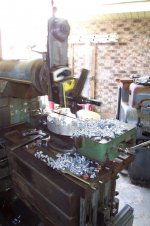projectnut
Stainless
- Joined
- Mar 4, 2006
- Location
- Wisconsin
I've had a little 7" AMMCO shaper for a few years. I've used it for flat work and slotting many times and it's always worked fine. Last week I needed to make a couple tool holders for small internal keyways. I welded a piece of 1" round stock to 3/8" x 1" flat stock. I then squared everything up and bored a hole through the round stock for a 1/2" boring bar.
Everything seemed true and square, but I thought I should set it up with a bar in the shaper just to make sure. I clamped the tool in the tool holder, extended the bar to the maximum length (12") and tightened it in the tool holder. The I setup a dial indicator on the table and hand cycled the ram. Much to my surprise the bar was moving almost .010 side to side as the ram went through the 7" stroke.
I narrowed the problem down to play in the clapper box. The clapper itself will move .005 side to side on the pivot pin. Not being a shaper expert I'm wondering if some play in the pin is normal, and if so what would be the maximum amount allowable before a repair is needed. I'm considering whether it's time to disassemble the box and insert a new pin or possibly bore it and the clapper for an oversized pin.
Everything seemed true and square, but I thought I should set it up with a bar in the shaper just to make sure. I clamped the tool in the tool holder, extended the bar to the maximum length (12") and tightened it in the tool holder. The I setup a dial indicator on the table and hand cycled the ram. Much to my surprise the bar was moving almost .010 side to side as the ram went through the 7" stroke.
I narrowed the problem down to play in the clapper box. The clapper itself will move .005 side to side on the pivot pin. Not being a shaper expert I'm wondering if some play in the pin is normal, and if so what would be the maximum amount allowable before a repair is needed. I'm considering whether it's time to disassemble the box and insert a new pin or possibly bore it and the clapper for an oversized pin.



 )
)


